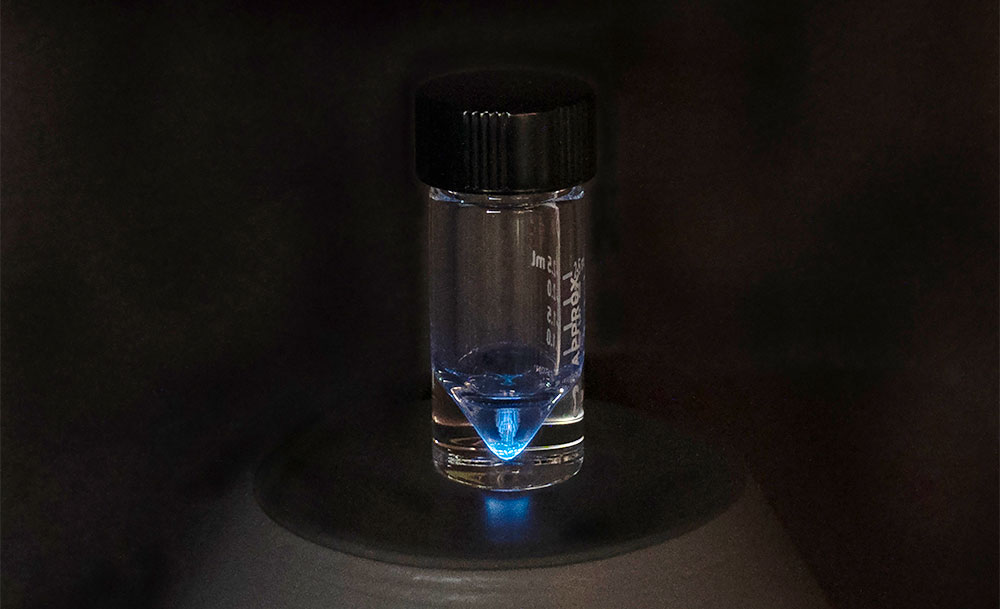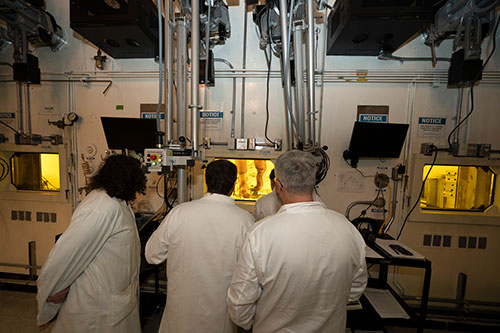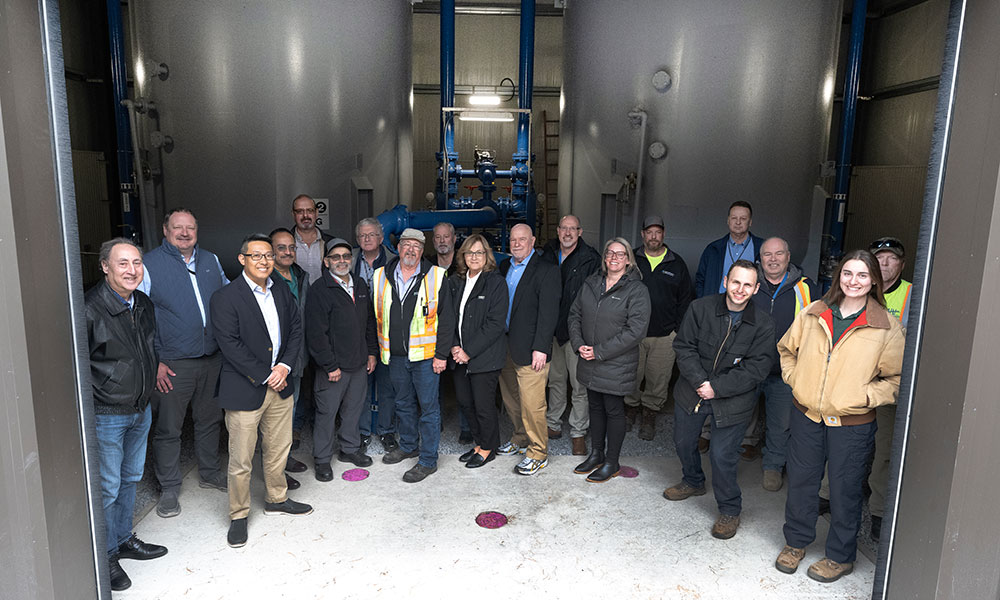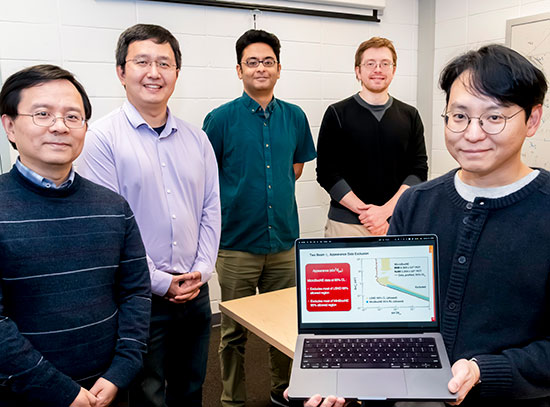Brookhaven Lab Staff Receive Secretary of Energy Achievement Awards
Medical isotope production, groundwater protection, electrical vehicle infrastructure among efforts honored
March 25, 2024
By Kelly Zegers and Joe Gettler
 enlarge
enlarge
This long-exposure image makes it possible to see the glow of actinium-225, an isotope that shows great promise for treating cancer. (Jessica Rotkiewicz/Brookhaven National Laboratory)
Radioisotope producers, groundwater protection professionals, and a fleet management leader at the U.S. Department of Energy’s (DOE) Brookhaven National Laboratory are among recipients of Secretary of Energy Achievement Awards for their accomplishments in 2023.
The awards, among the highest forms of recognition within DOE, are given each year for service above and beyond expectations and for contributions having lasting impacts on both DOE and the nation.
Energy Secretary Jennifer Granholm congratulated 53 exemplary teams across the DOE complex during a virtual awards ceremony on Feb. 20.
“I could not be prouder to call you all colleagues,” Granholm said. “You are public servants of the first order, and this country is better for your contributions. It is a privilege to work alongside you every day.”
Tri-Lab Effort to Increase Actinium-225 Supply
A trio of DOE national laboratories received a Secretary of Energy Achievement Award for their efforts to meet a growing demand for actinium-225 (Ac-225), a medical isotope.
Ac-225 shows promise as targeted treatment for certain aggressive cancers. It emits a short-range, powerful dose of radiation that could potentially kill cancer cells without damaging surrounding healthy tissues. Scientists from DOE’s Brookhaven National Laboratory, Oak Ridge National Laboratory (ORNL), and Los Alamos National Laboratory (LANL) work together in a tri-lab partnership sponsored by the DOE Isotope Program to produce and process the isotope and ship it out to research sites conducting clinical trials.
DOE's Under Secretary for Science & Innovation Geri Richmond presented the award, noting that Ac-225 has been long sought after by the medical community.
“Over a 10-year period, the heroic and enduring collaboration efforts of the team led to a renaissance in the field of nuclear medicine with research and development of new methods for creating new radioisotopes more quickly and more frequently to promote a stunning success in the treatment of various forms of cancer, particularly metastasized cancer,” Richmond said.
Brookhaven Lab produces Ac-225 and other radioisotopes at the Brookhaven Linac Isotope Producer (BLIP), a high-energy particle accelerator that is the flagship facility in the DOE Isotope Program. BLIP shares accelerator infrastructure with the Relativistic Heavy Ion Collider (RHIC) — a DOE Office of Science User Facility for nuclear physics research located at the Lab.
 enlarge
enlarge
Members of Brookhaven Lab's Isotope Research and Production team in the refurbished hot-cell area used for processing targets to make medical isotopes such as actinium-225 (Jessica Rotkiewicz/Brookhaven National Laboratory)
In 2023, Brookhaven began using new hot cells, specialized labs and equipment for processing radioactive materials, that enabled Brookhaven scientists to process and ship Ac-225 generated at BLIP straight to research centers. The upgrade doubled the number of processing sites for Ac-225 in the DOE’s Isotope Program and boosted the amount delivered.
“It’s an honor to be part of an effort that’s working hard to increase the availability of Ac-225 for encouraging radiotherapy research,” said Cathy Sue Cutler, chair of Brookhaven’s Isotope Research and Production Department. “We have a dedicated and talented team across the three labs, each with unique facilities at our hands to support this important program and our continued mission to develop radioisotopes.”
Since kicking off in 2014, the tri-lab research team has worked to enable and then ramp up production of enough Ac-225 to be able to support growing clinical trials and eventual drug applications.
“From small-scale experiments to routine production, it's truly been remarkable to witness the growth in this production effort,” said Allison Peacock, lead for the 4501 Operations Group in ORNL’s Isotope Science and Engineering Directorate. “Early stages focused on the development of the complex chemistry required to purify the Ac-225 product; now we focus on continuous improvement efforts to increase efficiency.”
ORNL research scientist Andrew Burgoyne added, “The demand for larger and more frequent batches of Ac-225 has grown tremendously in recent years. At Oak Ridge, we were delighted when Brookhaven established the capability to also process Ac-225, increasing availability.”
“We are proud to be recognized as part of this partnership,” said Dr. Kirk Rector, the point of contact at LANL for the DOE Isotope Program. “The Tri-Lab research team has been collaborating to enable a critical radioisotope that could play a valuable role in medicine. We look forward to continuing to work with our friends and colleagues at Brookhaven and Oak Ridge to help this collaboration meet its goals.”
PFAS Groundwater Remediation Team
 enlarge
enlarge
Members of the PFAS Groundwater Remediation Team with the one of two treatment systems (Kevin Coughlin/Brookhaven National Laboratory)
Some manufactured chemicals used since the 1940s across the United States are now recognized for creating risks for public health and the environment. Local, state, and federal officials, water service providers, and many others nationwide are working to address growing concerns related to these chemicals, called per- and polyfluoroalkyl substances (PFAS).
According to the Environmental Protection Agency (EPA), PFAS offer helpful characteristics in fire extinguishing foam, nonstick-food packaging, cosmetics, industrial processes, and other applications. But over time, the chemicals break down slowly while building up in people and the environment. Current peer-reviewed scientific studies show that exposure to certain levels of PFAS may lead decreased fertility for women, developmental effects or delays in children, increased risk of some cancers, and other negative impacts.
“PFAS were so widely used that contamination is an issue in areas across the country,” said Robert Gordon, manager of the DOE Brookhaven Site Office. “By addressing Brookhaven's legacy issue as others start their remediation efforts, the Lab's PFAS Groundwater Remediation Team has become a leader, role model, and resource."
In 2018, PFAS were detected in the groundwater at Brookhaven's current and former firehouse areas—where firefighting foams were used for training until 2008. In 2021, the Lab's PFAS Groundwater Project Team prepared and submitted design plans to county, state, and federal regulatory agencies to construct two groundwater treatment systems to remove PFAS using granulated activated carbon filter systems.
The remediation team reached a major goal when the first PFAS treatment system began operations in October 2022. The second system began operations in January 2023. Combined, the two systems treat approximately 750 gallons per minute of PFAS-contaminated groundwater. Monitoring results indicate the treatment systems are removing the PFAS compounds regulated in New York State to concentrations below the state's limits for drinking water.
This $10.9 million project was funded by the DOE Office of Science, General Plant Projects program. It was a successful collaboration among staff in Brookhaven Lab's Environmental Protection Division and Modernization Project Office, the DOE Brookhaven Science Office, and the DOE Office of Science's Science Laboratories Infrastructure Program.
Electrifying DOE’s Fleet
 enlarge
enlarge
EV charging stations have been added across Brookhaven Lab as part of a DOE-wide effort. (Kevin Coughlin/Brookhaven National Laboratory)
Amanda Kuzujian, Brookhaven Lab’s Fleet and Transportation Services and Mail Room supervisor, received a Secretary of Energy Achievement Award as part of a cross-DOE team working to electrify its vehicle fleet.
Deputy Secretary David Turk presented the award, recognizing the team for their “extraordinary dedication to an ambitious strategy to meet an executive order requiring federal agencies to reach 100% zero-emissions vehicle, or ZEV, acquisitions by 2035.”
The team, with members across the DOE complex, ordered more than 500 zero-emission vehicles in fiscal year 2023 and installed nearly 600 electric vehicle charging ports. They also created a Green Fleet Awards program to further promote the adoption of ZEVs across DOE's fleet, encouraging sites to embrace new innovation and cutting-edge technologies to serve as a model for other agencies and setting the stage for a more sustainable future, Turk said.
At Brookhaven, Kuzujian oversaw the recent addition of new charging stations across the Lab — and the program continues to expand.
“These stations are part of our ongoing commitment to sustainability and support for electric vehicle infrastructure,” Kuzujian said.
Brookhaven National Laboratory is supported by the Office of Science of the U.S. Department of Energy. The Office of Science is the single largest supporter of basic research in the physical sciences in the United States and is working to address some of the most pressing challenges of our time. For more information, visit science.energy.gov.
Follow @BrookhavenLab on social media. Find us on Instagram, LinkedIn, X, and Facebook.
2024-21690 | INT/EXT | Newsroom









